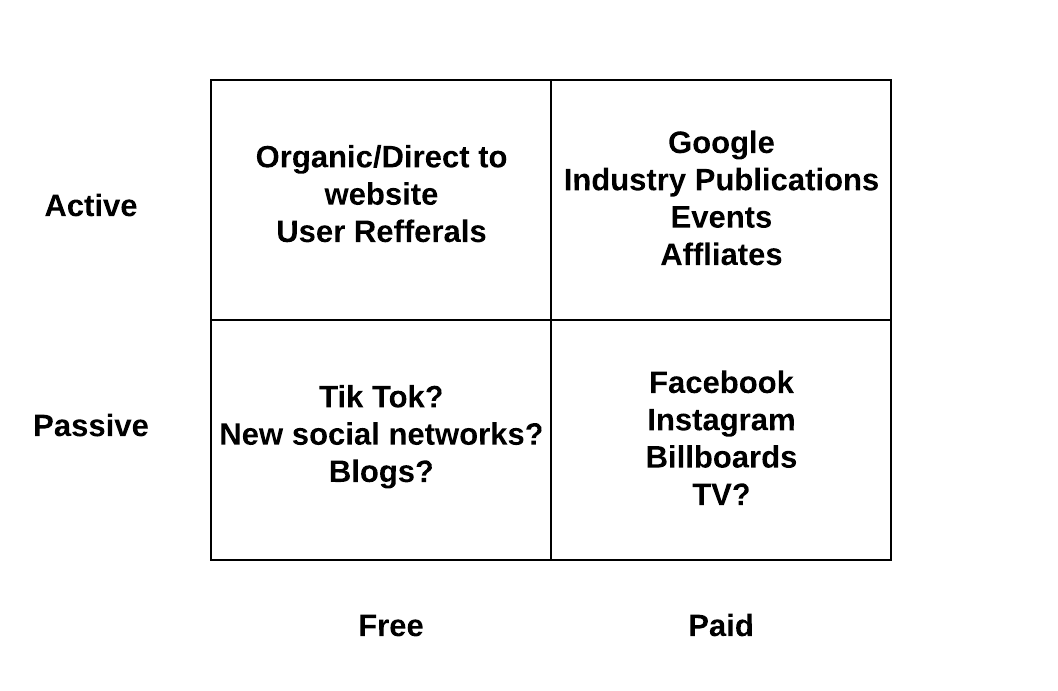In this post lets delve deeper into the mechanics of channels. As mentioned in my previous post, do not start this exercise before you have locked down your product value proposition and positioning.
Think deeply about LTV and set guardrails
What does the economics of your business look like? The most important thing is to align on is the value of your customer to you. What is the long term value of the customer (LTV)? Don’t be confused by the term “Long”. It’s up to you on how long you consider a customer to be using your product. Early on in a startup, it is better to have shorter periods. The more mature you are, you will have actual data on how long users use your service. You have to start by nailing down the exact equation on how you calculate LTV. This also forces you to think about the unit economics of the business. The biggest issue isn’t in creating the equation for LTV rather it’ getting a broad agreement with the team on the equation. Everybody has to believe in the assumptions and understand the specifics of how LTV is calculated.
With LTV defined and estimated, you can start getting an idea of how much you can spend to acquire that customer i.e the Cost of Acquisition (CAC). Ideally, you want to get to a point where your LTV is at-least double your CAC. Few companies manage to achieve that at the get-go, so it’s ok not to hit this level of efficiency right out of the gate. However, you should have a rough idea of a plan to get there. Doing the LTV/CAC exercise gives you a sense of what you are optimizing for.
A great side effect of this exercise is that you have an extremely clear understanding of how your business works. You know what are the key drivers for growth (these drive your LTV higher) and your key constraints for marketing spend (CAC).
What should you put in CAC?
This is a holy war question :).My suggestion is to make this as conservative as possible within reason. Your goal is to get an as accurate read as possible to what your value creation is. At the end of the day, the value you create in the business is LTV minus CAC. In practice, this means adding all the expenses that are directly tied to the acquisition effort. Anybody who directly touches the customer sale is considered a direct expense. So sales team salaries should be added to headcount (direct), but engineering expenses should not (indirect). Instead of providing a detailed example, I’m linking to this excellent tweet thread from 10-K diver on this topic.
Put in place your instrumentation and indicators
What good is an LTV/CAC calculation if you cannot measure it? Measurement can also feel like an endless loop but the LTV/CAC calculation will give you a guide to what has to get instrumented at a bare minimum. The LTV/CAC equations are the MVP analytics requirements. Instrumentation also gives you more fidelity on the leading and lagging indicators for the business. LTV is somewhat of a lagging indicator – LTV is realized only when the user finds value in your product. You want to know to think through and make some hypotheses and select your predictive leading indicators. What indicators can I influence that will make the LTV higher? is a good lens to look through.
Finally onto channels
After all this prep work, you are finally ready to think about channels. You have a clear understanding of your product, you have a view on LTV and know how much CAC you can afford. All this prep work pays off. Put simply channels are nothing but places where your users are likely to be.
At a high level, I divide the world into a simple 2×2 matrix.

- Passive hangouts: Places where your users’ hangout passively. If your product is a consumer good. Your users probably hang out on Facebook. If your product is targeted towards moms of toddlers, in addition to Facebook, your target customer also hangs out at parks. Passive hangouts are where your demo goes to relax or “hang out”. They are not looking for your product.
- Active hangouts: Places where your users are going to with intent. If your product is a home repair product, your users probably visit home depot or Amazon with an intent to buy your type of product. Google is an active hangout channel. Users go to google with an intent to find something.
- Paid Vs Free is pretty self-explanatory.
It’s pretty obvious that free channels are better than paid. Free has ZERO CAC. But as your business scales, you cannot escape paid acquisition. Consumer businesses have a better shot at growing organically (viral et al) but B2B businesses are harder to grow organically. Paid marketing is in everybody’s future. Fill out the 2×2 matrix and always start with optimizing the channels you think you have the highest number of users with the most intent. In my opinion, it is better to be super targetted and have a channel with a smaller audience but with high intent. Converting folks with intent into using your product is much easier. It is also a good signal if your product works. If highly interested users don’t use your product, why do you expect un-interested users to use them?
If you have reached this far, you now have a system and framework in place that you can optimize. Start running tests and measure, measure, measure. Start validating all your assumptions about leading/lagging indicators, your LTV, and CAC calculations i.e the performance of the entire acquisition engine.

Go forth and acquire!